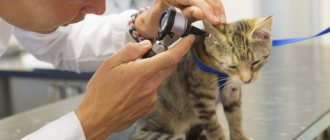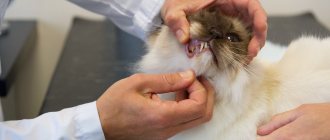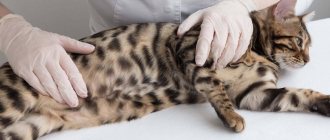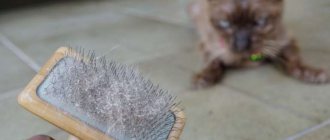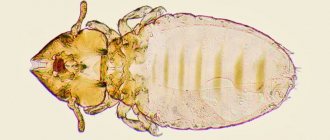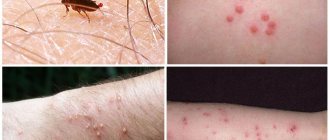Every cat experiences a skin disease at least once in its life. This problem applies to both street cats, which are easy targets for any infection, and homebodies who have almost no communication with their own kind. Skin diseases in cats cause damage not only to the health of the pet itself, but also pose a certain danger to humans. Therefore, it is necessary to know which of them are the most common. When the first symptoms appear in an animal, you should immediately contact a veterinarian. Fortunately, almost all non-advanced skin infections respond well to treatment and have a favorable prognosis.
Parasitic infections
Diseases caused by parasitic infestation may be:
- flea infestation;
- fungal (ringworm);
- mites (scabies, demodectic mange, otodectic mange, cheyletiosis, sarcoptic mange, notoedrosis).
Flea infestation
Flea infestation is a fairly common skin disease. If the parasites are not removed, it can be complicated by flea dermatitis, which is of an allergic nature. The main symptom of the disease is severe itching throughout the body. Parasites and their excrement can be seen with the naked eye if you part the cat's fur. The disease occurs through contact of healthy animals with sick ones, as well as simply being in a room where there are fleas. The owner can bring the eggs of the larvae into the house on his shoes after returning from the street.
Feeding on the blood of their victim, the parasites bite through the skin, releasing saliva into the wound, which thins the blood. This is what causes severe skin itching. The animal constantly scratches the bite site, damaging the skin, causing infection and provoking an inflammatory process.
Flea infestation is one of the few skin diseases that can be treated on your own without seeing a doctor.
You should know that fleas do not live on the skin of an animal, but only feed. The entire main process of life activity and reproduction occurs in secluded places in the apartment - in the fibers of the carpet, under the bed or in the crevices of the baseboards. This must be taken into account when implementing therapeutic measures. Therefore, treatment should include the following:
- animal processing;
- room treatment.
Treatment is carried out with drugs (insecticides) in several stages. Both adults and their eggs must be completely destroyed. Such treatments must be repeated at intervals of several months.
Fungal infections
Of the diseases of fungal etiology, ringworm is the most common.
Ringworm is a fungal disease that can be transmitted to humans. A cat becomes infected through contact with a sick animal. Fungal spores can be carried into the home on shoes or clothing. Microsporia is characterized by a very high speed of spread, gradually involving more and more new areas of the animal’s body in the process. Its main symptoms are:
- rounded areas of lost hair are localized on the cat’s head, paws and back;
- the affected skin is irritated and has an uneven scaly surface.
For treatment to be successful, it is important to start it early. A small area of damage is much easier to completely cure. The localization site is disinfected using antiseptics, after which an antifungal ointment is applied. The treatment is quite long. In more severe cases, antibiotic therapy is additionally administered.
Tick-borne infections
Tick-borne infections affecting cats are important to identify. After all, each of them has its own treatment regimen.
Scabies
Scabies is a mite-borne infection of the skin of animals. Its culprits are microscopic scabies mites. They are present on the skin of animals at any time, but are activated only when the body’s resistance drops for various reasons. Scabies is contagious to other animals and humans.
Demodicosis
Demodicosis is a dangerous tick-borne infection. The risk of infection occurs during the warm season - the period when these insects are active. Its symptoms are quite painful, since the disease covers large areas of the skin. By parasitizing under the skin of their prey, demodectic mites cause hair loss, redness of the affected areas, and pustular inflammation of the skin. The main therapy consists of prescribing antiparasitic drugs.
Otodectosis
The cause of otodectosis often lies in insufficient care of animals. Dirt and accumulation of wax in the ear canals become a breeding ground for the reproduction and activity of ear mites. The behavior of a cat when infected is very characteristic. She constantly shakes her head and suffers from itchy ears. The clinical picture is complemented by unpleasantly smelling dark crusts in the ears. If treatment measures are not taken, the condition becomes more serious. The inflammatory process, progressing, involves the eardrum. A possible outcome of the disease is hearing loss and damage to the meninges - meningitis.
The disease is treated with antiparasitic ear drops (Otovedin, Surolan, Otibiovin). The inflammatory reaction is well relieved by local ointments (“Sulfur ointment”, “Colloidal sulfur”).
Cheyletiosis
Cheyletiosis or “wandering dandruff” is caused in a cat by a special type of microscopic mite that affects the skin of the back along the spinal line. The disease can be recognized by its characteristic behavior. Experiencing severe itching, she rolls on the floor, trying to relieve it. The disease is treated with special injection drugs (“Pyrethrin”, “Fipronil”) and antiseborrheic shampoos. To increase the effectiveness of the drugs, long hair must be cut.
Sarcoptic mange
Sarcoptic mange is also a tick-borne infection that can occur in both cats and dogs. It causes symptoms similar to those of scabies. Ticks of this type can also infect human skin. The disease gradually goes away on its own, because the mite does not have the ability to reproduce in human skin. The drug "Stronghold" is well suited for the treatment of this disease. It is produced in drops, which are applied to the withers of the animal.
Notoedrosis
Another parasitic disease caused by the subcutaneous mite is called notoedrosis. Its causative agent is the microscopic subcutaneous mite Notoedres cati. The parasite lives in the skin of the animal's head and neck, gnawing passages in them, and thereby causing severe itching. The disease can be complicated by purulent dermatitis. The symptoms of the disease are very similar to the symptoms of demodicosis, so the final diagnosis is made based on microscopic examination of scrapings from the affected areas.
Treatment is carried out with anti-tick drugs (“Amitrazine”, “Sulfur ointment”, “Amit”).
Fungal otitis media
The disease is an inflammation of the external auditory canal. The development of fungal otitis occurs due to a weakened immune system. The pet shakes its head and scratches its ear.
The ears turn red quickly and strongly. When examining the ear with an otoscope, severe inflammation of the skin and many fungal deposits are observed.
Every day you need to clean the ear of accumulated secretions with napkins and cotton swabs. Afterwards you need to treat them with alcohol-based antiseptics.
Allergic reactions
Quite often, cats experience allergic reactions of various origins. The most common are household, food and drug allergies. It manifests itself most often in the form of dermatitis. In localized areas, the fur usually thins out or falls out completely, and itchy areas appear, which causes great discomfort to the animal. The symptoms and treatment of various forms of allergic reactions are usually the same. In most cases, antihistamines are prescribed. But the most important thing is to identify which substance is the allergen and eliminate it.
Atopic dermatitis
Atopic dermatitis is a disease of an allergic nature. Usually caused by various external factors - dust, detergents, pollen. Its signs are progressive baldness in the neck, ears, abdomen or between the thighs, irritation and ulcers on the skin, itching.
The disease is treated with broad-spectrum antimicrobials and antihistamines.
Miliary dermatitis
Miliary dermatitis, in most cases, is also of an allergic nature, although it can occur as a result of bacterial, fungal infection, helminth infection, hormonal or autoimmune disorders.
It can be recognized by a finely nodular itchy rash and active hair loss in areas where the skin is affected.
The diagnosis and cause of the disease are determined during a comprehensive examination: scrapings are taken from the surface of the skin, and a laboratory analysis of the hair is performed. If this is not enough, the doctor may prescribe a skin biopsy.
Treatment is prescribed based on the results of the diagnosis. The cause of the pathological reaction of the body is eliminated and supportive therapy is prescribed.
Feed intolerance
A food allergy can occur when a pet is switched to a different diet. This form of the disease is characterized by both skin and gastric manifestations - urticaria, nausea, vomiting, loose stools. Sometimes there are symptoms of eosinophilic granuloma - nodular formations in the lips and mouth. If no measures are taken, anaphylactic shock may develop.
Causes of sores throughout the body in cats
Damage to the skin is caused by sources of various types. These may be hereditary, infectious or anthropogenic (man-made) factors. The condition of the skin is affected by food changes, poor water quality, or even stress caused by moving to a new place of residence. Scabs, ulcers, and small wounds progress quickly without timely treatment. They cause the pet great discomfort and pain. The cat becomes nervous, scratching the affected areas.
Some ailments do not have obvious manifestations. It is possible to notice pathology only with a thorough examination of the animal. The most obvious is refusal to eat, apathetic state, and constant scratching. The wounds can be of different shapes and colors. They have one thing in common - this is an external manifestation of a serious internal disease.
The main factors may be:
- poor nutrition;
- genetics;
- allergies;
- bacterial and fungal infections;
- blood-sucking or intestinal parasites: ticks, fleas, worms;
- weak immune system.
This diversity means that pathology may well occur in almost any mustachioed friend. There are many specific reasons for this. A specialist in a veterinary clinic can find out the cause of the appearance of ulcers, wounds or scabs, as well as select the correct therapy.
Bacterial infection
Skin diseases caused by bacterial infections have two forms of development - dry (with the formation of dry scales and crusts) and wet (ulcers and blisters filled with exudate).
Bedsores
If an animal has suffered a serious illness or a complex surgical operation, the recovery period usually requires immobility, which is fraught with bedsores. They are formed at the site of prolonged contact of the body with the litter tissue. To prevent bedsores, the cat requires careful care - frequent turning over, treating places where there is a risk of bedsores with disinfectants and camphor alcohol.
Eczema
Animals with hypersensitive skin are at higher risk of developing eczema. The etiology of the disease can be different:
- Traumatic damage as a result of prolonged exposure to the skin (friction, scratching from bites, burns).
- Neuropathy is a consequence of various internal disorders (systemic diseases, diabetes, hormonal disorders).
- Physical and chemical damage. In this case, the disease is provoked by chemical burns or irritating substances affecting the skin.
The disease begins with itchy rashes and blisters on the skin, and local fever. Subsequently, the lesions dry out, leaving flaky areas or, conversely, degenerate into a festering, weeping wound.
Treatment is long-term and includes the prescription of local medications in the form of soothing ointments and powders, and antibiotic therapy.
Acne
The cause of acne (blackheads) is usually low immunity, improper care and stress of the animal. This is a bacterial infection that affects the sebaceous glands. You can recognize it by pustular rashes all over the body. Acne is most often localized on the chin and around the lips.
Depending on the severity of the lesion, local or general therapy is used.
First of all, the skin is treated with antiseptic detergents:
- tar soap and shampoo;
- antiseborrheic shampoos.
Then local antiseptics are applied:
- "Chlorhexidine";
- "Miramistin";
- hydrogen peroxide.
In especially severe cases, the doctor prescribes topical antibiotics (Mupirocin) or corticosteroids (Prednisolone).
Ear mites
Ear mites appear as a result of improper care. Symptoms: scratching, foul odor from the ears, dark gray discharge, redness of the skin of the ears, fever.
Treatment can begin after visiting a veterinarian. Various aerosols (based on Dermatosol or Tsiodrin), drops (Bars, Tsipam, Amitrazine) and ointments (Nicochloran, Phenothiazine) are used. Dark discharge should be removed with a soft cotton cloth or cotton wool.
Skin diseases of other etiologies
Skin diseases in domestic cats may be a consequence of loss of psychological balance, hormonal imbalance or some other imbalance in the body.
Psychogenic alopecia
The diagnosis of “psychogenic alopecia” is made to an animal when there is rapid hair loss. This condition is caused by prolonged stress or neurosis, which can occur:
- when changing place of residence or owner;
- when another cat or a new family member appears;
- after being alone for a long time.
First of all, the groin area, stomach, sides, and center line of the back lose hair. The exposed skin shows no signs of inflammation. Sedatives and antidepressants help relieve this condition:
- "Cat Baiyun";
- "Stop stress";
- "Amitriptyline."
More emotional breeds of cats are susceptible to the disease - Siamese, Abyssinian, Himalayan.
Cushing's syndrome
Hormonal imbalance in the body can provoke a very rare disorder - Cushing's syndrome. It is caused by excessive production of the animal hormone cortisone by the adrenal glands. Its main symptoms are:
- hair loss;
- behavioral changes (sudden aggression);
- increasing weakness;
- increased appetite and thirst.
The disease can be provoked by uncontrolled use of hormonal drugs. Conservative and surgical methods are used for treatment:
- the drug "Trilostane", which suppresses the production of hydrocortisone;
- if the symptoms are caused by a pituitary tumor, it is removed surgically.
Severe disease may require surgical removal of the adrenal glands, in which case the animal will be required to undergo hormone replacement therapy throughout its life.
Psychogenic alopecia
Due to thorough and prolonged licking, cats may develop bald spots. This behavior means that the pet is stressed. Sometimes baldness occurs due to allergies and fungal diseases.
First you need to check your pet for parasites and make sure there is no hypersensitivity to external irritants.
General rules for the treatment of skin diseases
Cats have sensitive skin, which makes them susceptible to epidermal diseases more than other animals. The situation is complicated by the fact that many of them like to walk on their own, so their social circle cannot be limited in any way.
A sick cat requires careful care. Parasitic infections are contagious and take quite a long time to treat, so the cat needs to be isolated from other animals and people. When communicating with her, you must be careful, but do not make her an outcast in the family. This is especially true for kittens, because they really need the affection and attention of their owner.
It is very important to carefully follow all doctor’s orders and bring the animal to the clinic at certain intervals to monitor the dynamics of the disease.
Modern veterinary medicine has a rich range of medicines that can cope with almost any skin infection. If you do not miss the disease at the initial stage of its development, then it will not be difficult to cure it.
Preventive actions
The complex of preventive measures to prevent skin diseases in cats must include:
- Regular visits to the veterinarian.
- Timely treatment with antiparasitic and anthelmintic drugs. Using flea collars.
- Food quality control. It is unacceptable to feed your cat economy class food.
- Maintaining hygiene in areas where animals are kept. Your cat's bowl and litter box should be kept clean.
If your pet has at least one of the signs of a skin pathology, it should be shown to a doctor immediately.
Demodicosis
This is a dangerous invasive disease caused by the bites of microscopic ticks. Cats often suffer from this disease during the warm season, when the parasites are at their most active.
Symptoms of demodicosis include:
- the formation of dense tubercles on the pet’s body, when pressure is applied to them, white clots are released;
- constant scratching and skin rashes;
- redness of the affected areas;
- partial baldness;
- presence of red crusts;
- formation of pustules during the duration of the disease.
Attention. It is this skin disease that most often leads to death.
Treatment of cats for demodicosis involves the use of antiparasitic agents (lotions, shampoos, collars, powders), injections and treatment of affected areas with anti-inflammatory drugs.
Diagnostics
Your veterinarian will start with a complete medical history and physical examination. This is especially important due to the extensive list of differentials (see Reasons). Many causes vary slightly in appearance and distribution.
The wide variety of possible causes and the similarity of many manifestations make the diagnosis and treatment of dermatological skin disease difficult. To find out the true nature of the disorder, a detailed history will be required, which you will provide.
A history of itching will be taken into account, as well as exposure to infectious organisms and recent travel history (to account for some fungal diseases that may be transmitted from environments other than the one in which you and your cat live).
Diet and any other signs of systemic (whole body) reactions will also be recorded.
Lesions, ulcers and blisters will require a biopsy for deeper analysis. Your veterinarian will perform a histologic skin biopsy—an analysis of the affected tissue as well as mycobacterial and/or fungal cultures, as well as an assessment of fluid and pus from the lesion or blister.
An aspirated sample of the fluid and subsequent microscopic examination of the involved cells in the fluid will also be used to determine the presence of a bacterial infection, aerobic or anaerobic (bacteria that can live with or without oxygen, respectively).
Viruses
Skin ailments and dermal irritation in cats caused by exposure to various viruses are rare. Pathological skin conditions occur against the background of herpes virus infection, calcivirosis, and feline leukemia. In addition to the appearance of lesions, small ruptures of the mucous membranes are noted.
Antibiotics, antiviral drugs, immunomodulators, and symptomatic agents are used in treatment to eliminate the main symptoms. Treatment of viral diseases requires long-term treatment, and in some cases the cat is prescribed lifelong maintenance therapy.

